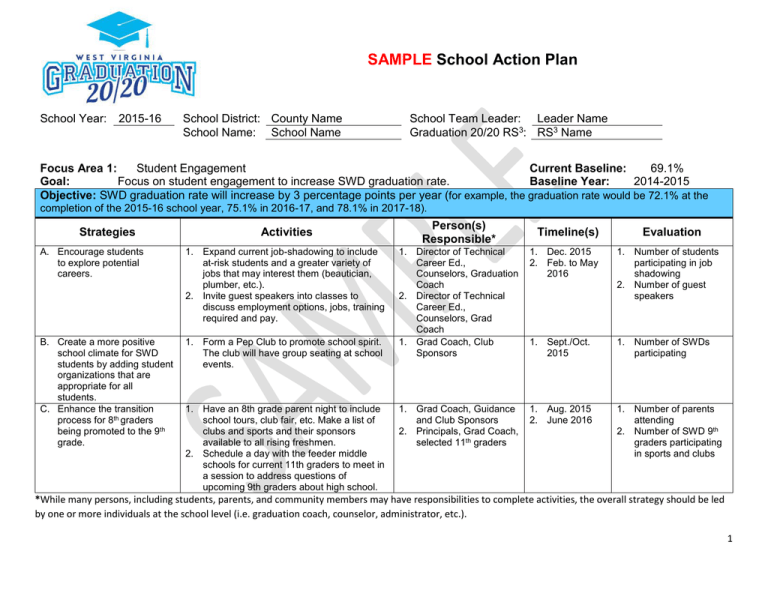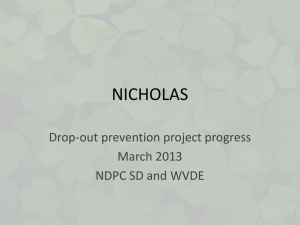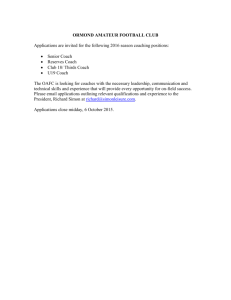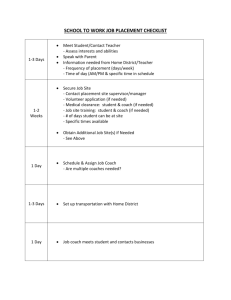SAMPLE School Action Plan
advertisement

SAMPLE School Action Plan School Year: 2015-16 School District: County Name School Name: School Name School Team Leader: Leader Name Graduation 20/20 RS3: RS3 Name Focus Area 1: Student Engagement Current Baseline: 69.1% Goal: Focus on student engagement to increase SWD graduation rate. Baseline Year: 2014-2015 Objective: SWD graduation rate will increase by 3 percentage points per year (for example, the graduation rate would be 72.1% at the completion of the 2015-16 school year, 75.1% in 2016-17, and 78.1% in 2017-18). Strategies Activities A. Encourage students to explore potential careers. 1. Expand current job-shadowing to include at-risk students and a greater variety of jobs that may interest them (beautician, plumber, etc.). 2. Invite guest speakers into classes to discuss employment options, jobs, training required and pay. B. Create a more positive school climate for SWD students by adding student organizations that are appropriate for all students. C. Enhance the transition process for 8th graders being promoted to the 9th grade. 1. Form a Pep Club to promote school spirit. The club will have group seating at school events. 1. Have an 8th grade parent night to include school tours, club fair, etc. Make a list of clubs and sports and their sponsors available to all rising freshmen. 2. Schedule a day with the feeder middle schools for current 11th graders to meet in a session to address questions of upcoming 9th graders about high school. Person(s) Responsible* Timeline(s) Evaluation 1. Director of Technical Career Ed., Counselors, Graduation Coach 2. Director of Technical Career Ed., Counselors, Grad Coach 1. Grad Coach, Club Sponsors 1. Dec. 2015 2. Feb. to May 2016 1. Number of students participating in job shadowing 2. Number of guest speakers 1. Sept./Oct. 2015 1. Number of SWDs participating 1. Grad Coach, Guidance and Club Sponsors 2. Principals, Grad Coach, selected 11th graders 1. Aug. 2015 2. June 2016 1. Number of parents attending 2. Number of SWD 9th graders participating in sports and clubs *While many persons, including students, parents, and community members may have responsibilities to complete activities, the overall strategy should be led by one or more individuals at the school level (i.e. graduation coach, counselor, administrator, etc.). 1 SAMPLE School Action Plan Focus Area 2: Academic Engagement Current Baseline: 1.2% Goal: Focus on academic engagement to decrease SWD drop-out rate. Baseline Year: 2014-2015 Objective: SWD drop-out rate will decrease by 0.3 of a percentage point per year (for example, the drop-out rate would be 0.9% at the completion of the 2015-16 school year, 0.6% in 2016-17, and 0.3% in 2017-18). Strategies A. Keep students on track for graduation and motivated by incorporating student credit recovery. B. Provide alternative and creative academic support and enrichment opportunities. C. Increase positive behaviors of SWDs who have been identified as having at-risk school behaviors. Activities Person(s) Responsible Timeline(s)* Evaluation 1. Create Virtual School credit recovery program. Open school computer lab for this purpose. 1. Graduation Coach, counselors 1. Jan. to June 2016 1. Number of students successfully completing credit recovery 1. Offer enrichment activities at different times from core classes, or as electives, or as after school programs. 2. Recruit school staff, parents and/or community members to provide tutoring. 3. Establish partnerships with community organizations and/or postsecondary institutions to offer additional enrichment programs to SWDs. 1. Start a Buddy Program for identified SWDs. 2. Develop implementation plan for the program. 3. Pair selected SWD with a responsible general education student who will serve as a mentor. 4. Assign volunteer faculty member to mentor SWD and general education student pairs. 5. Develop contact sheets for mentors and faculty to track number and nature of contact hours. 1. Principals, school faculty, Grad Coach 2. Grad Coach, school faculty 3. Grad Coach 1. 2015/16 School Year 2. Sept./Oct. 2015 3. Oct./Dec. 2015 1. Class/activity participation roster 2. Number of SWD using tutoring program Academic performance of participants 3. SWD participants in programs 1. Grad Coach, counselors, teachers 2. Grad Coach 3. Grad Coach 4. Grad Coach, participating faculty 5. Grad Coach 1. Sept. 2015 2. Sept. 2015 3. 2015/2016 school year 4. Oct. 2015 5. Sept. 2015 1. List of selected students 2. Program plan 3. Academic performance and discipline data of selected SWDs 4. Academic performance and discipline data of selected SWDs 5. Contact sheets *Establish realistic timelines that drive the activities toward completion. Some activities may be completed in a short timeframe, while others will continue for months or the entire school year. 2 SAMPLE School Action Plan Focus Area 3: Attendance Current Baseline: 92.6% Goal: Develop school programs, policies and environment to increase attendance. Baseline Year: 2014-2015 Objective: SWD attendance rate will increase by half a percentage point (0.5) per year (for example, the attendance rate would be 93.1% at the completion of the 2015-16 school year, 93.6% in 2016-17, and 94.1% in 2017-18). Person(s) Responsible Strategies Activities A. Create an incentive program to reward students who improve their attendance. 1. Identify at-risk SWD, ask them what would motivate them to attend school. 2. Leverage existing staff/student groups to develop an incentive program. 3. Involve parents and community (as stakeholders and contributors). 4. Communicate incentive program to students. 5. Use attendance coordinator or similar to track attendance and award incentives. 1. Recruit school staff to act as mentors. 2. Have staff and SWD collaborate to create the parameters for the program (frequency of meeting, activities, etc.). 3. Develop and have mentors use a frequency of contact log. 4. Monitor SWD program participants’ attendance rates. 1. Graduation coach, teachers, SWD 2. Grad coach, teachers, students 3. Grad coach, school administrator 4. Grad coach 5. Attendance coordinator 1. Develop a family-school communication plan. 2. Recruit staff, students and parents to form an attendance response team. 3. Have attendance response team develop plans, strategies and tools to use. 4. Boost afterschool programs/offerings. 5. Create an intake plan for mobile students. B. Develop mentoring program between at-risk SWD and school staff. C. Initiate multi-tiered system of support to reduce chronic absenteeism. Timeline(s) Evaluation 1. 2. 3. 4. 5. SWD survey Program plan Sign-in sheet Dissemination log Number of incentives given (change in attendance rate) 1. Grad coach, school administrator 2. School staff, SWD 3. Grad coach, school staff 4. Grad coach, Attendance coordinator 1. Sept./Oct. 2015 2. Sept./Oct. 2015 3. Sept./Oct. 2015 4. Oct. 2015 5. 2015/16 school year 1. Sept. 2015 2. Sept./Oct. 2015 3. Oct. 2015 4. 2015/16 school year 1. 2. 3. 4. Staff participation Program description Contact log Change in attendance rate 1. Attendance coordinator, school administrator 2. Attendance coordinator 3. Response team lead 4. School administrator, parents, community 5. Attendance coordinator 1. Sept. 2015 2. Sept. 2015 3. Sept./Oct. 2015 4. 2015/16 school year 5. Sept. 2015 1. Communication plan 2. Staff, student, parent participation 3. Tool kit 4. Number of offerings 5. Intake plan 3 SAMPLE School Action Plan D. Improve school climate to keep at-risk SWD engaged. 1. Participate in School Climate Survey, with SWD participation. 2. Use survey results to inform areas of improvement. 3. Initiate programs/interventions to address areas identified for improvement. 1. School administrator, teachers 2. Grad coach, school administrator, teachers 3. Grad coach, school administrator, teachers 1. Fall 2015 2. Winter 2015/16 3. Spring 2016 1. Participation in survey 2. List of areas identified for improvement 3. List of programs/ interventions NOTES: Some strategies and activities are more ‘big picture’, while others are more detailed. This is normal. It is fine to have a variety of strategies and activities, you know best what is achievable in your school. Your Action Plan may include universal interventions (school wide initiatives) and interventions for targeted groups, such as at-risk SWD. Not ALL activities are required to have an evaluation component, but most will. Also, for some activities, it is to be expected that the person(s) responsible and timeline(s) may be the same. The following is a visual way to think about the terms goal, objective, strategy, and activity: A high level, big picture perspective of a desired result; the achievement toward which effort is directed Goal Objective Evidence based framework that organizes activities into meaningful categories A specific, measurable, attainable, realistic, and time-bound statement aligned to a goal Strategy Activity The individual actions that must take place to implement the strategy 4








